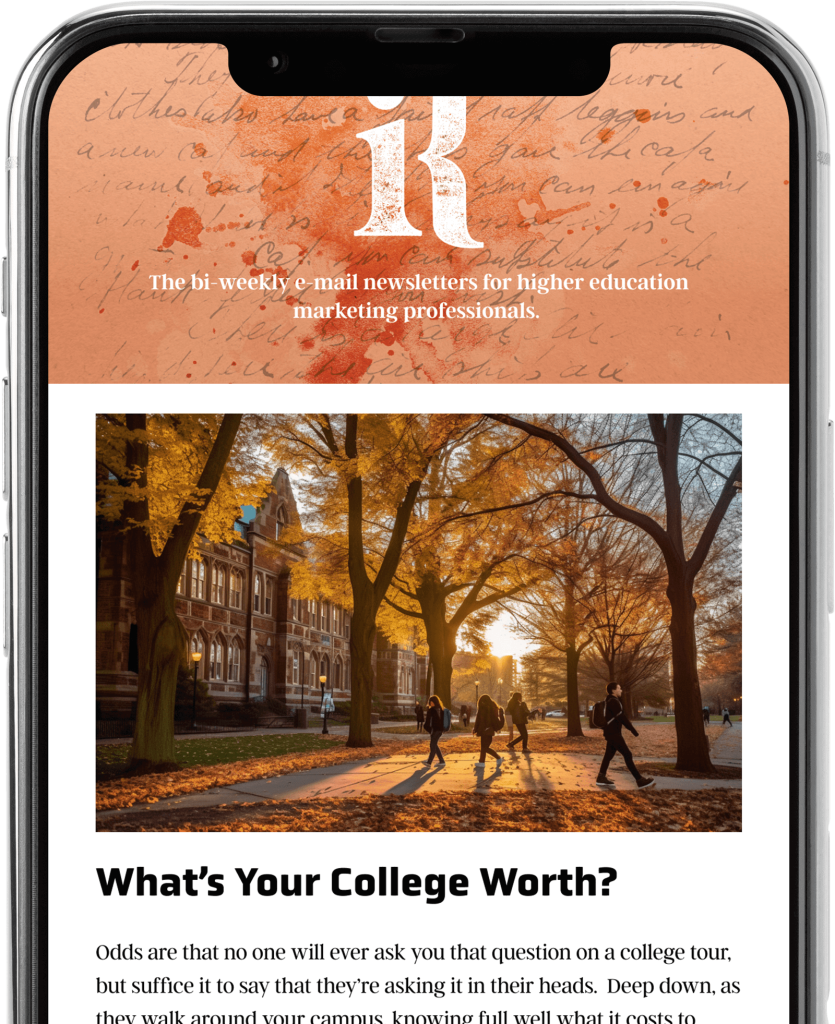Institutional Positioning
Who Are You Even Competing Against?

Asking the Key Question
When my wife and I were expecting our third child, we both knew it was time for us to re-think our family car. At the time, she and I both drove smaller SUVs perfectly capable of taking two kids to school or out to dinner. But having a third child just months away spelled trouble for us. If we ever wanted to go on a family trip and transport all five of us—along with luggage and a stroller—we agreed that we wanted to have a bigger car.
We quickly found ourselves on the Internet looking for different larger SUVs and mini-vans. When we’re both leaning toward an SUV instead of a mini-van and immediately focused on finding larger SUVs with a third row and cargo space. One more factor we sought was a “pass-through” feature where our oldest could walk back to the third row without having to climb over a seat or adjust the lever to pull the seat down.
We immediately found three cars from different manufacturers that potentially fit the bill and set out to do our test drives as a family. The first car, which we ultimately purchased, checked all of the boxes. The test drive went well, our oldest was excited about his seat, and it felt safe and secure, and the unmistakable new car scent was palpable. As our test drive ended and the kind salesman prepared to send us off, he asked one final question of us as we prepared to go drive two other vehicles: “what other cars will you be looking at?”
Feeling no pressure but knowing he wanted to make the sale, we kept our cards close to our chest (knowing we might have to negotiate) and candidly shared with him the other choices. We shared that the second option was our next visit and that we had a family member who had that car and was happy with it. We also shared option three and explained that my wife was particularly drawn to that one. If I’m being honest, we sort of felt like we’d end up with option three all along.
The salesman quickly but politely and intentionally gave us some parting words. Option three, which he didn’t seem too worried about losing the sale to, wasn’t likely going to be for us. “There’s no pass-through in that vehicle and they’re not available because of the supply issues.” Knowing our sense of urgency given the upcoming birth, he sunk option three pretty easily.
When it came to option two, he had some more specific words, possibly because he saw it as a threat to his sale. “Pay attention to how that vehicle rides. It feels more like a truck whereas ours rides like a car.” But perhaps the kicker, which he knew, was more about a feature that had little to do with the car itself and more about the experience. “Do you use Apple CarPlay in your current cars?” he asked, knowing that the feature that linked our iPhones to the car was likely important. “For sure,” we answered in the affirmative. He smelled blood. “Just know that [option three] phased out CarPlay some time ago. If you choose that car you’re choosing not to have CarPlay.” We still took the test drives but in this moment we silently decided to buy option one (the car he was selling). We called him the next day to ask about placing our order.
It seems indelicate to compare buying a car to choosing a college. I’m not suggesting that these decisions are on the same plane. But what we can agree to is that they are large, considered purchases often involving more than one decision-maker. And while we hope that there is more sophistication and existential thought involved in choosing a higher education path to follow, buying a car is an example of product marketing in its purest form. And if we deconstruct it, we can apply this thinking to our quest to find more students.
Finding Your Competitive Set
The essence of what we can learn from this scenario lies in one question: “what other options are you considering?” As we think about drawing more of the right students to our institutions, we have to begin here. If we don’t stop to think about what other options our prospective students are likely considering, it becomes impossible to even begin thinking about where our institution fits within that competitive set. And while we can ask each student about the schools they are considering (like the car salesman asked my wife and me), we will inevitably get a smorgasbord of responses. Instead of doing that one at a time and hoping that our campus tour guides can manage their way through any conversation, let’s look instead at the situation holistically.
Your college’s competitive set is the list of schools that keep you up at night: the ones you know your prospective students will be touring before and after they visit yours. They’re the ones that are geographically similar to you or have a cost or aid component that is always. Stopping to think about the 7-8 schools that you typically compete against is key to understanding where our distinction lies and how to begin the process of drawing the distinctions we need to attract the right students for us.
You can probably make this list off the top of your head with some refining through a group discussion. To check your work, or if the list doesn’t come easily, look to the National Student Clearinghouse to discover where you are losing admits to other schools. The data will show you where the students you were recruiting ultimately landed. The schools where most of your former candidates ultimately enrolled are the ones we belong in your competitive set.
Keep in mind that this list should not be exhaustive: we’re not looking to list every school that every prospective student is considering. We’re looking for the sweet spot—the handful of schools that most of our prospective students are thinking about most of the time. This is a particularly good instance to let the 80/20 Principle guide you.
Like what you're reading?
Subscribe to our newsletter to get the latest insights in Higher Education and thought leadership.


